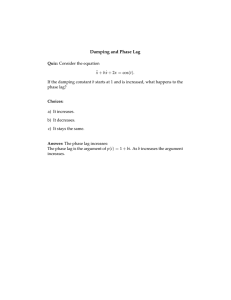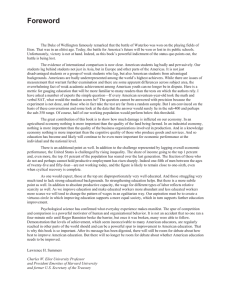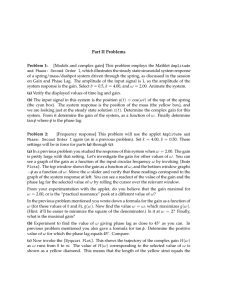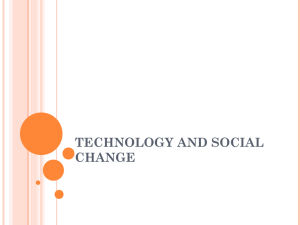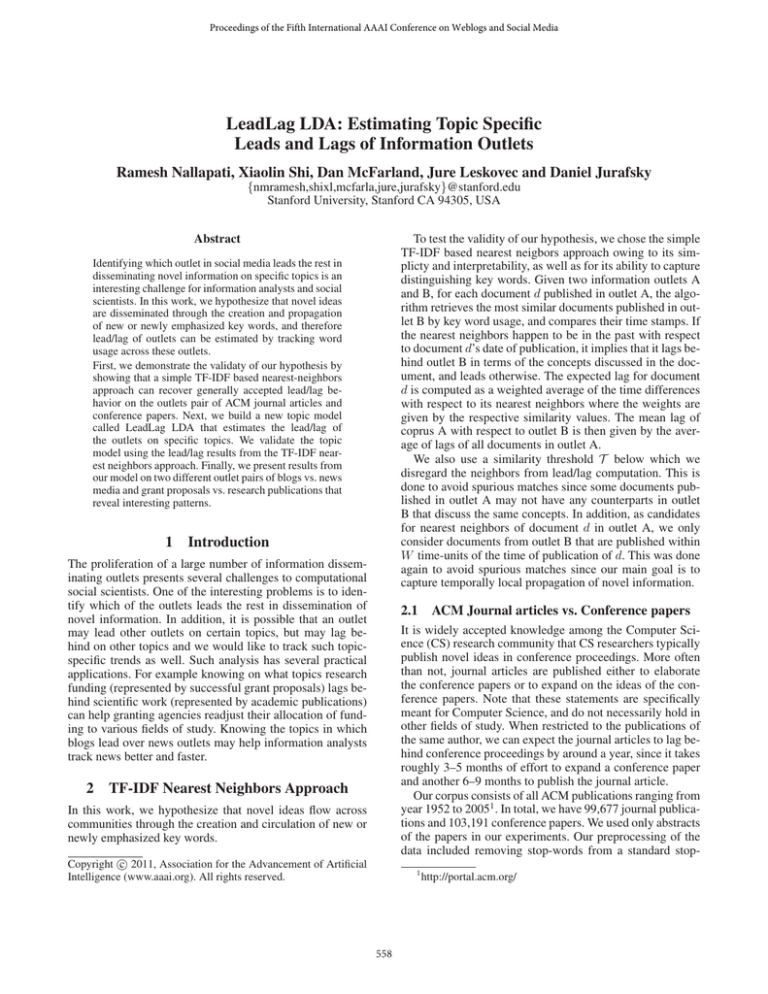
Proceedings of the Fifth International AAAI Conference on Weblogs and Social Media
LeadLag LDA: Estimating Topic Specific
Leads and Lags of Information Outlets
Ramesh Nallapati, Xiaolin Shi, Dan McFarland, Jure Leskovec and Daniel Jurafsky
{nmramesh,shixl,mcfarla,jure,jurafsky}@stanford.edu
Stanford University, Stanford CA 94305, USA
To test the validity of our hypothesis, we chose the simple
TF-IDF based nearest neigbors approach owing to its simplicty and interpretability, as well as for its ability to capture
distinguishing key words. Given two information outlets A
and B, for each document d published in outlet A, the algorithm retrieves the most similar documents published in outlet B by key word usage, and compares their time stamps. If
the nearest neighbors happen to be in the past with respect
to document d’s date of publication, it implies that it lags behind outlet B in terms of the concepts discussed in the document, and leads otherwise. The expected lag for document
d is computed as a weighted average of the time differences
with respect to its nearest neighbors where the weights are
given by the respective similarity values. The mean lag of
coprus A with respect to outlet B is then given by the average of lags of all documents in outlet A.
We also use a similarity threshold T below which we
disregard the neighbors from lead/lag computation. This is
done to avoid spurious matches since some documents published in outlet A may not have any counterparts in outlet
B that discuss the same concepts. In addition, as candidates
for nearest neighbors of document d in outlet A, we only
consider documents from outlet B that are published within
W time-units of the time of publication of d. This was done
again to avoid spurious matches since our main goal is to
capture temporally local propagation of novel information.
Abstract
Identifying which outlet in social media leads the rest in
disseminating novel information on specific topics is an
interesting challenge for information analysts and social
scientists. In this work, we hypothesize that novel ideas
are disseminated through the creation and propagation
of new or newly emphasized key words, and therefore
lead/lag of outlets can be estimated by tracking word
usage across these outlets.
First, we demonstrate the validaty of our hypothesis by
showing that a simple TF-IDF based nearest-neighbors
approach can recover generally accepted lead/lag behavior on the outlets pair of ACM journal articles and
conference papers. Next, we build a new topic model
called LeadLag LDA that estimates the lead/lag of
the outlets on specific topics. We validate the topic
model using the lead/lag results from the TF-IDF nearest neighbors approach. Finally, we present results from
our model on two different outlet pairs of blogs vs. news
media and grant proposals vs. research publications that
reveal interesting patterns.
1
Introduction
The proliferation of a large number of information disseminating outlets presents several challenges to computational
social scientists. One of the interesting problems is to identify which of the outlets leads the rest in dissemination of
novel information. In addition, it is possible that an outlet
may lead other outlets on certain topics, but may lag behind on other topics and we would like to track such topicspecific trends as well. Such analysis has several practical
applications. For example knowing on what topics research
funding (represented by successful grant proposals) lags behind scientific work (represented by academic publications)
can help granting agencies readjust their allocation of funding to various fields of study. Knowing the topics in which
blogs lead over news outlets may help information analysts
track news better and faster.
2
2.1
ACM Journal articles vs. Conference papers
It is widely accepted knowledge among the Computer Science (CS) research community that CS researchers typically
publish novel ideas in conference proceedings. More often
than not, journal articles are published either to elaborate
the conference papers or to expand on the ideas of the conference papers. Note that these statements are specifically
meant for Computer Science, and do not necessarily hold in
other fields of study. When restricted to the publications of
the same author, we can expect the journal articles to lag behind conference proceedings by around a year, since it takes
roughly 3–5 months of effort to expand a conference paper
and another 6–9 months to publish the journal article.
Our corpus consists of all ACM publications ranging from
year 1952 to 20051 . In total, we have 99,677 journal publications and 103,191 conference papers. We used only abstracts
of the papers in our experiments. Our preprocessing of the
data included removing stop-words from a standard stop-
TF-IDF Nearest Neighbors Approach
In this work, we hypothesize that novel ideas flow across
communities through the creation and circulation of new or
newly emphasized key words.
c 2011, Association for the Advancement of Artificial
Copyright Intelligence (www.aaai.org). All rights reserved.
1
558
http://portal.acm.org/
1. For each document d:
words list, stemming the words using the Porter Stemmer2 ,
and removing the words that occur in less than 5 documents.
We are finally left with 20,552 unique terms from journals
alone. We discarded all terms from conferences data that do
not occur in journals data.
We implemented the TF-IDF algorithm using the Lucene
search engine3 . The similarity is computed in terms of
Lucene’s Practical Scoring Function4 between the TF-IDF
weighted term vectors of the documents. After indexing all
the conference abstracts, we converted each journal article
into a query of at most 25 top TF-IDF words, and retrieved
the conference abstracts that matched the query. We then
scored these matches using the Lucene similarity function,
and computed mean lag. In all our experiments below, we
fixed the maximum number of nearest neighbors, Nmax , to
5 and W to 5 years.
Figure 1 presents a histogram of lags of journal articles
with respect to conference papers published by the same author for various values of the similarity threshold T . The
results are aggregated over multiple authors. Although there
2.
sample mixture over topics θd ∼ Dir(·|α)
3.
For each position i in 1, . . . , Nd :
4.
sample topic zi ∼ Mult(·|θd )
5.
toss a biased coin ti ∼ Ber(·|λ)
6.
if(ti = 1)
7.
8.
9.
10.
sample nearest neighbor n ∼ Mult(·|δd )
sample word wi from Mult(·|βnzi )
else
sample word wi ∼ Mult(·|βzi )
Table 1: Generative process of the Lead/Lag Topic Model. Nd is
the length of document d.
3
LeadLag LDA
The TF-IDF nearest neighbor approach is effective at capturing overall lead/lag of corpora, but we are also interested
in estimating lead/lag by specific topics. In this work, we
propose a new topic model called LeadLag LDA that can
capture topic specific leads and lags of knowledge outlets.
The new model is a topic model analog of the nearest neighbors approach and works in the following 3 steps:
1. Learning step: In this step, we run the standard LDA
model (Blei, Ng, and Jordan 2003) on all documents from
outlet B, with respect to which we want to estimate lead/lag
(e.g.: conferences data in the ACM outlets example), and
learn the topics in the corpus in terms of the topic mixture
prior α and the topic specific distributions over the vocabulary {β1 , . . . , βK }, and the word-to-topic assignments for
all the documents in the corpus, where K is the number of
topics.
2. Nearest neighbors step: For each document in outlet A,
whose lead/lag we want to estimate (e.g.: journals data in the
ACM outlets example), we identify its nearest neighbors in
outlet B using the TF-IDF approach.
3. Inference using LeadLag LDA: Using the nearest neighbors for each document and the learned values of the LDA
model on outlet B as the input, we perform inference on
documents from outlet A using LeadLag LDA outlined in
Table 1.
The new LeadLag model is similar to LDA in that it generates a topic assignment zi for each word-position i in the
document d from the document’s mixture over topics given
by θd (steps 1 through 4 in Table 1). However unlike LDA
which samples the word wi from the topic specific distribution βzi , the LeadLag model performs a biased coin toss
with a probability λ (step 5 in the table). If the coin shows
heads, it draws a neighbor n from a multinomial distribution
δd over its neighbors and then draws a word from the neighbor using the probability βnzi w (steps 7 and 8 in the table)
which is given by:
Figure 1: Lead/Lag histograms of ACM journal articles with respect to conference papers published by the same authors. The plots
are for four different values of the similarity threshold T . The histograms show that at reasonably strong thresholds, there is a clear
signal that journal articles lag behind conference papers by approximately 1 year.
is no clear signal of lag of journal articles at T = 0, the histogram starts shifting to the right as we increase T from 0 to
0.4. At a threshold of 0.4, the mean lag is approximately 1
year, which agrees quite closely with our intuition about the
field of computer science research that it takes about 1 year
for an author to expand a conference paper into a journal article. This result is in good agreement with the broad trends
in computer science that experts agree upon, and therefore
proves our hypothesis that key word usage across outlets can
be used to estimate their leads and lags. In all our subsequent
experiments, we set T to 0.4.
βnzi w = κ
2
http://tartarus.org/∼martin/PorterStemmer/
3
http://lucene.apache.org/java/docs/index.html
4
http://lucene.apache.org/java/3 0 1/api/core/org/
apache/lucene/search/Similarity.html
cn (w|zi )
+ (1 − κ)βzi w
cn (zi )
(1)
where cn (w|zi ) is the number of times that the word w is
assigned to topic zi in the neighbor document n, c(zi ) is
559
the document’s total count of assignments of topic zi , and
κ is a smoothing parameter that is set to 0.9. Therefore, the
model highly encourages the document to borrow topic specific language from one of its nearest neighbors. The probability δdn , which is topic independent, represents the likelihood that the document d used the same language as that in
n. To complete the generative story, if the biased coin shows
tails, the model reverts to the original generative process of
LDA, in which the word is sampled from the learned distribution over the vocabulary βzi (step 10 in Table 1). The
coin toss probability λ is a tunable parameter, which we set
to 0.9 to encourage each document to reuse vocabulary from
its neighbors as much as possible.
We estimate the parameters of the model using variational
EM (Blei, Ng, and Jordan 2003), the details of which we
skip owing to space constraints. Once we estimate δd , the
expected lag of document d with respect to outlet B is given
by:
δdn (T (n) − T (d))
(2)
Lag(d) =
Figure 2: Comparison of lag estimated by LeadLag LDA with that
of TF-IDF model as a function of threshold. Estimates of LeadLag
LDA align very closely with those of TF-IDF.
We also compared the log-likelihood estimates of LeadLag LDA with those of LDA on the ACM journals data.
We found that LeadLag LDA is able to outperform LDA at
T > 0.2 because it is able to learn better from the additional
information of high quality neighbors. At lower thresholds,
the nearest neighbor matches are more noisy, resulting in
poorer predictive power of the model. Also, for higher number of topics, the LeadLag LDA suffers from sparsity of
topic-specific information, and is therefore unable to outperform LDA until relatively higher thresholds are reached.
n∈N (d)
The mean lag is then given by averaging the lags of all documents in outlet A. In addition to the mean lag which is topic
independent, one could also compute topic-specific lags of
the outlet A using the following equation:
(d∈A;(θdk Nd )>4) Lag(d)θdk
(3)
Lag(A; k) =
(d∈A;(θdk Nd )>4) (θdk )
4
where Nd is the length of document d. In other words, the
topic-specific lag of outlet A on topic k is estimated simply as the weighted average of lags of all documents in A,
where the weights are the relevance of the corresponding
documents to the topic k. In the above equation, for each
topic k, we only considered those documents for lead/lag
estimation that have at least 4 words assigned to that topic
in expectation.
We implemented LeadLag LDA by extending and modifying David Blei’s LDA code in C5 . We also built a multithreaded implementation of this code that allows us to scale
the model to the large corpora we used in our experiments.
3.1
4.1
We ran a 50 topic LeadLag LDA on the twin outlets of
grants and science. The grants outlet is represented by successful NSF grant proposals6 , while ‘science’ is approximated by all publications from the ISI dataset7 . We focused
our analysis in the area of Computer Science. From the
ISI dataset consisting of most academic journal publications
since 1960’s, we extracted abstracts from Computer Science
publications based on the “Field” labels, which resulted in
471,553 documents. A vast majority of the these documents
are uniformly distributed in the timespan between 1991 and
2008. We also have successful grant proposals data from
NSF whose awards are mostly from year 1990 to 2009. We
extracted all Computer Science abstracts from this dataset
using the NSF program names, which resulted in 12,388 abstracts. After stopping and stemming the NSF corpus, and
removing words that occur in less than 5 documents, we
ended up with a vocabulary of 8,326 unique terms. We used
the same vocabulary in the ISI corpus as well, and discarded
any terms unseen in the NSF corpus.
Figure 3 shows the lag of grants with respect to science in Computer Science on various topics. The plot shows
that NSF grants lag behind science on topics in Computer
Science such as ’Information Retrieval’, ‘Computer Aided
Health Care’, ‘Mobile Networks’, and ‘Network Security’,
by around a year, but has a slight lead on other topics such
as ‘Databases’ and ‘Algorithms’.
Evaluation of LeadLag LDA
Since we do not have any ground truth labeled data in terms
of lead/lag for topics, we use the results from the TF-IDF
nearest neighbors model as the ground truth for evaluation
purposes. This is a reasonable approximation, since we already validated the TF-IDF nearest neighbors model on the
ACM Journals vs. Conferences data. The LeadLag model
can estimate topic-specific lead/lags using Eq. 3, but one
could also compute topic-independent lead/lag by using Eq.
2, which could be compared with the values generated by
TF-IDF nearest neighbors approach.
Figure 2 shows the lag estimates of the TF-IDF model and
LeadLag LDA at various values of the similarity threshold
T . Both the curves are in good alignment, validating LeadLag LDA as an accurate model for lead/lag analysis.
5
Results and Discussion
CS Grants vs. Science
6
7
http://www.cs.princeton.edu/ blei/lda-c/
560
http://www.nsf.gov
http://www.isiknowledge.com
model lead/lag by specific topics. In the topic modeling family, the work of (Gerrish and Blei 2010) comes closest to
our work. In this paper, the topic specific impact of a document is modeled in terms of the document’s ‘language’ that
is reused by other documents published in its future. However, the goal of their work is modeling impact of individual
documents, while we are interested in modeling the lead/lag
of outlets in disseminating novel information.
LeadLag LDA is related to the Citation Influence model
(Dietz, Bickel, and Scheffer 2007) in terms of its broad design. The goal of the Citation Influence model is to capture
the relative importance of a document’s citations in influencing the document’s content. Their approach was to allow
each document to ‘copy’ topics for its word generation from
the cited documents. The Lead/Lag topic model has an analogous goal of capturing the relative influence of its nearest
neighbors on its own content. However, we address the problem differently, by requiring the document to ‘copy’ from its
neighbors topic specific words explicitly, rather than topics
themselves. This constrains the model to capture similarity
of documents in terms of topic-specific word usage, rather
than the looser requirement of topical similarity.
In this work, we empirically validated our hypothesis that
lead/lag of outlets can be captured by tracking usage of key
words by testing a simple text based TF-IDF model on ACM
Journals vs. Conferences outlet pairs where general agreement on lead/lag behavior exists. We also built a new LeadLag topic model that can compute lead/lag by topics, and
validated it against the TF-IDF model. The output of the
model on three different outlet pairs presents interesting insights into their topic-specific lead/lag behavior.
Although there has been considerable work in the past in
terms of modeling influence using network information, research on using textual data to model diffusion of information is only beginning to emerge. We hope that this work
encourages other researchers to pursue this promising line
of research more vigorously.
Figure 3: Number of years by which NSF grants lag behind ISI papers resolved by topics in Computer Science. Topics are described
in terms of their top 10 most likely terms. NSF leads on ’Databases’
and ’Algorithms’ (last two bars in the histogram) but lags behind
on other topics of Computer Science such as ‘Speech Recognition’
(second bar from top), ‘Computed Aided Health Care’ (fourth bar
from top), ‘Mobile Networks’ (sixth bar from top), etc.
4.2
News vs. Blogs
Figure 4: Number of seconds by which news lags behind blogs
resolved by topics. Topics are described in terms of their top 10
most likely terms. News leads blogs on topics such as ‘Sports’ (bottom most bar), ‘Politics’ (second bar from bottom), but lags behind
blogs on topics such as ‘Adult content’ (first and fourth entries from
top), and ‘Business’ (third bar from top).
For this run, we used a subset of the Spinn3r index8 that
consists of all entries from the entire day of 2010-10-22.
The dataset has a variety of outlet types including blogs,
news, Twitter feeds and Facebook postings. We identified
news stories by matching the URLs of the posts with a list
of 18,615 URLs we indexed from Google News9 . All other
postings that do not have the words ‘twitter’ or ‘facebook’ in
their URLs are treated as blog entries. After removing posts
that are less than 10 words long, we are left with 1,769,228
blog postings and 247,543 news stories. We pruned the vocabulary using the standard procedure on the news corpus,
which gave us 233,442 unique words. We trained a 25 topic
LDA (to minimize the computational effort and to reduce
sparsity for topical lag computation) on the blogs corpus and
ran inference using LeadLag LDA on the news corpus. Figure 4 lists the topic-specific lags of news for a few selected
topics. The results show that while the news outlets lead on
traditional news topics such as ‘Sports’ and ‘Politics’, blogs
lead on ‘Business’ and ‘Adult Content’.
5
Acknowledgments
This research was supported by NSF grant NSF-0835614
CDI-Type II: What drives the dynamic creation of science?
We wish to thank our anonymous reviewers for their deeply
insightful comments and feedback.
References
Blei, D.; Ng, A.; and Jordan, M. 2003. Latent dirichlet allocation. Journal of Machine Learning Research 3:9931022.
Dietz, L.; Bickel, S.; and Scheffer, T. 2007. Unsupervised
prediction of citation influences. In Proceedings of the 24th
International Conference on Machine Learning.
Gerrish, S., and Blei, D. 2010. A language-based approach
to measuring scholarly impact. In International Conference
on Machine Learning.
Ramage, D.; Manning, C. D.; and McFarland, D. A. 2010.
Which universities lead and lag? toward university rankings
based on scholarly output. In NIPS Workshop on Computational Social Science and the Wisdom of the Crowds.
Related Work and Conclusion
Recently (Ramage, Manning, and McFarland 2010) presented LDA based techniques to model which universities
lead the rest using similarity in the topic space. Their approach, though highly related in intent to ours, does not
8
9
http://www.icwsm.org/data/; http://www.spinn3r.com/
http://news.google.com
561

